
ICCROM_ICS03_ReligiousHeritage_en
.pdf
9
[The preservation and management of religious heritageis dealt with]at both ontological
and technical levels in this paper. By ontological we mean understanding the core of the religion and the power that distinguishes a sacred object from other similar artefacts. A sacred object for a man of faith transcends its physical appearance and transforms the faithful to a state of spiritual presence. This relation by itself is an essential aspect of religious heritage.
This paper – presented in the format of a case study – will focus on shariah concepts of ‘ritual pollution/ purification’ and ‘unclean substances’ as well as the distinction between the realms of ‘religious’, ‘sacred’ and ‘secular’ for Islamic objects as important principles in setting up guidelines for the management
of Islamic collections. Following this, the particular guidelines established in the Islamic Arts Museum Malaysia illustrate the process of handling objects in the collections as valuable items of religious importance.
[Amir H. Zekrgoo and Mandana Barkeshli]
Collection management of Islamic heritage in accordance with the worldview and Shari’ah of Islam
Before proceeding to the issue of management of a religious heritage, one must understand what ‘religious heritage’ is all about, and why and in what way it
shall be preserved. Religious heritage includes not only tangible items, but also covers, in a wider and deeper sense, the intangible reality from which the artefacts and the whole religious culture issue. The intangible religious reality is the powerful force that lives in a religious person, gives meaning to his life, signifies his place in the universe, and defines the relationship of the universal element to him and to another in accordance with divine law. The many layers of religious cultures that have developed so colourfully since time immemorial until the present age, and have produced exquisite artefacts, all emanate from that single source; the divine source or the unseen universal reality, without which the whole world of religious culture would be but a facade, a
body without a soul. We shall also bear in mind that religious heritage cannot be understood or preserved without understanding its people, and viewing the monuments, the artefacts and the whole culture from the viewpoint of the people who have produced it.
In this paper we will introduce concisely the components of Islamic tradition and give a brief description of shari’ah or the Islamic law. We will also deal with the question of ‘ritual pollution’ and ‘ritual purification’ since they can help in setting guidelines for the management of Islamic collections. In this respect ‘unclean substances’ are introduced.
To be able to maintain the sacred boundaries one must be able to distinguish between the realms of ‘religious’, ‘sacred’ and ‘secular’ within the Islamic culture this is another issue of discussion in this paper. In the last section we intend to share with the reader some practical guidelines that we have been following in the Islamic Arts Museum Malaysia.
94 Conservation of Living Religious Heritage
These guidelines were set out as steps towards a reform (however minor) of our process of handling objects so that they should be in accordance with the aforesaid Islamic conventions. In the past few years we have gained valuable information and experience, especially from those visitors who viewed our collection not as objects of mere aesthetic value, but rather as valuable items of religious importance. Inspired by them and taking into consideration the guidelines of Shari’ah, we took small steps towards the establishment of a collection managed according to Islamic values. Such steps will be presented in the format of a case study.
islAmic TrAdiTion
A religious view is tightly connected with a ‘tradition’. Any belief or practice of a ‘traditional nature’ is:
1) received from the hands, lips, or examples of others rather than through discovery or invention;
2)received on the assumption that the authors and transmitters are reliable and therefore the tradition valid; and
3)received with the express command and intention of future transmission without substantial change. Therefore the source and the path are both considered authentic, reliable, and must be respected.
Hence, as a source of knowledge, tradition is to
be distinguished from rumour and fashion. Rumour and fashion, although received from others, cannot necessarily be assumed to be reliable or be accepted as transmission without alteration; on the contrary, they invite speculation and elaboration. Tradition, however, purports to embody a fixed truth from an authoritative source (see Valliere in Eliade 1987: Vol. 15, 1–15).
Religious traditions inform us about the origin and destiny of things. Sometimes they tell of a golden age of the past or anticipate a glorious future, and often they address both past and future as if they are addressing their audience from a timeless status. ‘Remember’ is the first commandment of a sacred tradition, reminding people of the rules and realities presented to them from pre-eternal times.
In Islam, the formal concepts of tradition, the Sunnah ‘custom’ or ‘example’ of the prophet, were compiled in the third to fourth centuries AH (ninth to tenth centuries AD) in the six books of genuine hadiths. The Islamic faith is based on ‘believing the unseen’. It is stated clearly in the Qur’an that the ‘divine guidance’ provided by the ‘Book’ would only guide ‘those who have faith in the Unseen…’.(2:3)
The first and the most fundamental rule therefore is believing in an unseen source, the presence of the
creator who is ‘the knower of the unseen and the manifest’ (al-a’alim al-ghaib wa al-shahadah). This view explains the universe at two levels of ‘concealed’ or ‘inner’ dimension (al-batin) and the manifest or tangible dimension (al-zahir). The seeker of the two is the one who walks the path, moving from the realm of the manifest to the realm of the concealed. This spiritual path is governed by shari’ah. Shari’ah is an Arabic term used to designate Islamic law. The word occurs once in the Qur’an, at 45: 18 (‘We have set you on a shari’ah of command, so follow it’), where it designates a way or path divinely appointed. By following the shari’ah a believer may follow the spiritual path (tariqa) that leads him ultimately to the realm of Absolute, or the Truth (Haqiqa). In other words Islam consists of a divine law (al-shari’ah), a spiritual path (al-Tariqah) and the truth (al-Haqiqah), which is the origin of both the Law and the Way (see Nasr 1985 and 1987).
riTuAl polluTion And prescribed purificATion
Virtually all aspects of life may be surrounded by the notion of pollution. The concept of pollution and purity are found in all the religious and spiritual orders of the world. Here, pollution and purity are seen from both internal as well as external points of views. The two concepts may not be studied as separate phenomena as they are two separate aspects of one reality; like light that could not be understood without darkness, the very meaning of purification is essentially connected to our understanding of pollution.
The word pure in itself indicates simplicity and originality, cleanness, a substance that is free from any different inferior contaminating material. It has its connection with truth as it carries with it the meaning of absolute, utter, sheer, without any discordant qualities.
Purification in its religious senses is staying or becoming clean and clear from religious pollution. The purification of religious pollution is a major religious theme because it forges a path of healing, renewal, transcendence and reintegration, establishing harmonious triangular links with the individual, the cosmos, and the social structure.
There are wide ranges of human activities that may be connected to the issue of pollution. Such activities may be divided into three general categories, namely bodily function, social bounding, and the maintenance of sacred boundaries (see Preston in Eliade 1987: Vol. 12, 91–99).
Our main concern in this paper is aimed at the bodily function, such as handling objects of religious reverence in a museum, which relates
9 • Collection management of Islamic heritage in accordance with the worldview and Shari’ah of Islam |
95 |
|
|
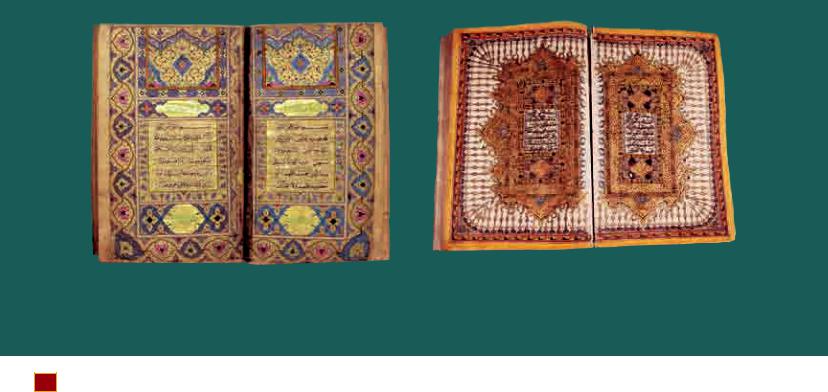
directly to touching and presenting such objects. Setting guidelines for the handling of such objects will also contribute to the preservation of the core and essence of religious reality that is the maintenance of sacred boundaries. In this respect one of the major issues for a curator, keeper, conservator and restorer is to determine what substances or conditions are considered impure by the authority of a religion.
Ideas about purity and impurity are linked to complex symbolic systems in virtually every society. One of the most widespread concepts of pollution is associated with excretions from the human body. Urine and faeces are particularly impure. Other body secretions, such as saliva, vomit, menstrual blood, and afterbirth, are also considered to have polluting qualities. Sperm is also considered polluting outside the sanctified context of marriage.
All these bodily excretions have social significance. They are usually surrounded with heavy ritualization to ensure that they will be contained with a specific religious, cultural, temporal, or spatial context (Preston ibid.).
The Islamic term for impurity is nijisa and the impure subjects are defined as najis. All major Islamic schools (Hanbali, Hanafi, Maliki, Jafari and
Shafii) consider the following as ritually impure: dog, pig, corpse, blood, semen, human urine and excrement, and liquid intoxicants. People may also be regarded as impure (najis) if they do not have faith in the true God. ‘O you who believe truly the pagans are unclean’ (Qur’an 9:28).
The leaders of all the Islamic schools of jurisprudence (fiqh) have considered prescribed purity (taharah) to be a basic condition for the validity of worship (ibadah). It is not an exaggeration to say no other religion has given such importance to prescribed purity as Islam.
Taharah literally means ‘purity’. In the terminology of the jurisprudence it implies the removal of physical impurities such as blood and excrement (khabath). To attain the state of prescribed purity from a ritual impure state, one should first remove the ‘unclean substance’ or its traces off the concerned area of the body. A state of prescribed purity may be attained by the removal of impurities and, in some cases, by the performance of ablution (wudhu), bath lustration (ghusl) or dry purification (tayammum) (Bakhtiar 1996: 3–4).
Pure water must be used for the performance of ablution (wudhu) and bath lustration (ghusl). Dry purification does not concern the subject of this paper. For Muslims, water represents the ‘purified example of purity’, and for the mystics it is a symbol of the highest ecstasy and spirituality.
Ablution is the ceremonial washing of the human body, or specific parts of it. Ablution is a symbolic action meant not to create only physical ‘cleanness’ but to remove ritual uncleanness or pollution. Ablution is performed to correct a condition of ritual impurity, and to restore the impure to a state of ritual purity. The ritually impure (or unclean) person is prohibited from performing certain functions and participating in certain rites (Drijvers in Eliade 1997: Vol. 1,
Figure 1 Pages of the Qur’an. Iran. 1684 CE. 30 x 6.5 cm. Collection of the Islamic Arts Museum Malaysia.
Figure 2 Pages of the Qur’an. Malay Peninsula, Terengganu. Late18th century CE. 43 x 28 cm. Collection of the Islamic Arts Museum Malaysia.
96 Conservation of Living Religious Heritage
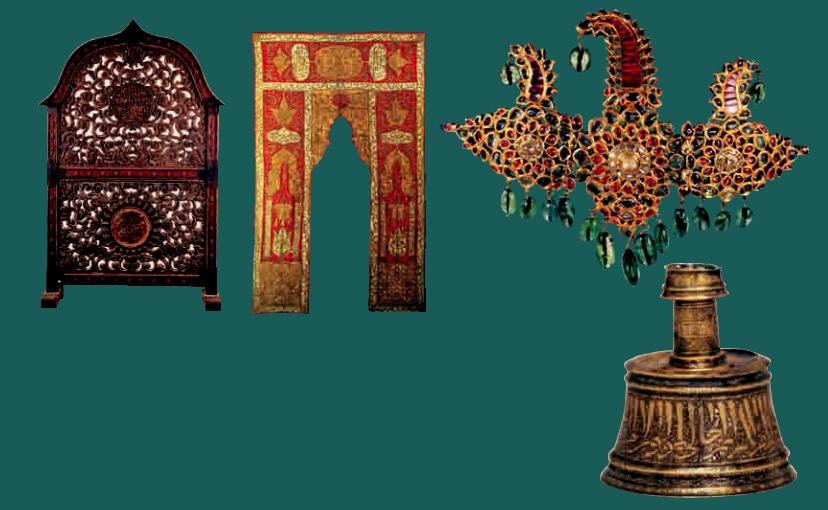
9–13). Among such functions is the touching of the Holy Scriptures. The most holy object for a Moslem is the Holy Qur’an, which is the embodiment of the divine words (Fig.1 and Fig. 2). Handling a copy of the Qur’an with respect is a religious duty.
The maintenance of sacred boundaries
The divine words embodied in the holy Qur’an are considered most sacred by the Muslim community. It is important, therefore, to note here that the items inscribed with Qur’anic verses must be treated in a special manner.
Although a wide variety of artefacts may be listed under the general category of Islamic art, not all of these are considered sacred. This is because ‘sacred’ and ‘religious’ do not necessarily refer to the same thing. The term ‘religious art’ may be applied to any form of art related to the manifested body of religion, be it a painted depiction of an event in the history of religion, or a visual description of a religious subject. This subject may be of an earthly
nature, such as a painting of a religious ceremony, or it may have emanated from the supernatural and metaphysical realm referred to in the holy scriptures, such as scenes of creation, paradise, the day of judgement, etc. Objects of ritual importance such as prayer carpets, prayer screens (Fig. 3), portable mihrabs (Fig. 4), robes, belt, swords, and portraits of the saints, also fall under ‘religious art’.
Not every example of religious art is also sacred art, so the latter may be considered a branch of the former. Sacredness is a quality that transcends the material domain of religion, and associates itself with the divine. Its function is not of a descriptive nature, but of a transforming one. Religious icons such as Christian icons, or statues of certain deities in the Hindu sphere, are considered sacred, as they possess a distinct quality by which the worshipper is transformed to a state of transcendence.
This may confuse, and has confused many western and especially non-Moslem scholars in their study of Islamic art. They look for Islamic elements in, say, a Persian carpet or a Mughul jewellery
Figure 3 Prayer Screen. Indonesia, Jambi. Late 19th century CE. 143.5c. x 95cm. Collection of the Islamic Arts Museum Malaysia.
Figure 4 Mosque Portiere. Turkey or Syria. 19th century CE. 176 x 294 cm. Collection of the Islamic Arts Museum Malaysia.
Figure 5 Turban Ornament. India. 18-19th century CE. Collection of the Islamic Arts Museum Malaysia.
Figure 6 Candle-stick. Egypt or Syria. 1293-1341 CE. Collection of the Islamic Arts Museum Malaysia.
9 • Collection management of Islamic heritage in accordance with the worldview and Shari’ah of Islam |
97 |
|
|
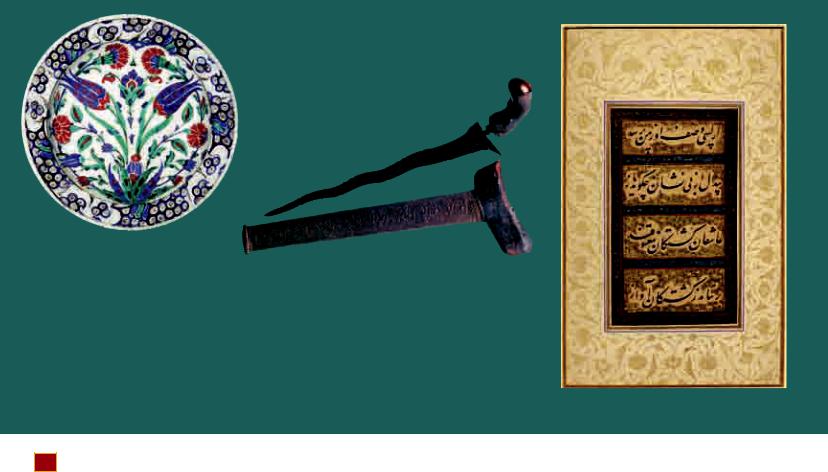
piece (Fig. 5), something that may not be found. It is important to note that for a Muslim anything accomplished with sincerity and good intention is a step towards performing his duty to his Creator and is therefore Islamic. This applies to art as well. An exquisite piece of Mamluk candlestick metalwork (Fig. 6), a fine piece of Iznik Ottoman dish (Fig. 7), an ornamented keris – the traditional weapon of the Malay Archipelago (Fig. 8), and a fine piece of calligraphy of Persian poetry (Fig. 9) are all equally recognized as Islamic art.
Such pieces are neither religious nor sacred, yet they are all representative of Islamic art. Technical treatment of such items need not be different from other artefacts. However, if any of the above items carry Qur’anic verses on them (and there are quite a few such examples) then the treatment and handling is different (Figs. 10a-b). The illustrated Ottoman linen tunic, for example, is inscribed with Qu’ranic verses and numerals in black and red ink (Fig. 10b). Such tunics were worn under armour and were believed to protect wearers from harm during battle.
Copies of the Qur’an above all else require special treatment, as they are considered to be manifestations of divine wisdom and command. This is because Qur’anic verses carry with them the essence of the sacred. Verses of the Qur’an are not
only important because of the divine message they carry; the script carrying it is considered sacred in itself. Therefore an impure substance, or a person in a state of ritual impurity, shall not come in contact with the scripture: ‘That this is indeed a Qur’an most honourable, in a Book well-guarded, which none shall touch but those who are clean’ (Qur’an 56:77, 78, 79).
The above verse appears on the cover of many copies of the Qur’an. Fig. 11 shows a Chinese manuscript of the Qur’an with the verse in Sini style on its cover.
Collection management
Every museum has its own culture. Culture in this sense is defined as the ‘total of the inherited ideas, beliefs and knowledge which constitute the shared basis of social action’ and ‘the total range of ideas and activities of a group of people with shared traditions which are transmitted by members of the group’. An understanding of museum culture and its collections helps the collection managers to communicate purpose and commitment in their museum. However, to fully comprehend the impact of culture one must understand its symbols, language, ideology, beliefs, rituals and myths. The importance of culture to museums and galleries has only recently received
Figure 7 Iznik dish. Turkey. 1575-1580 CE. 6.5 x 32 cm. Collection of the Islamic Arts Museum Malaysia
Figure 8 Keris. Indonesia, Riau. 1717 CE. 14 x 41cm. Collection of the Islamic Arts Museum Malaysia.
Figure 9 A folio of Persian Poetry. Nastaliq style. 17th century CE. 15.2 x 8.6cm. Collection of the Islamic Arts Museum Malaysia.
98 Conservation of Living Religious Heritage
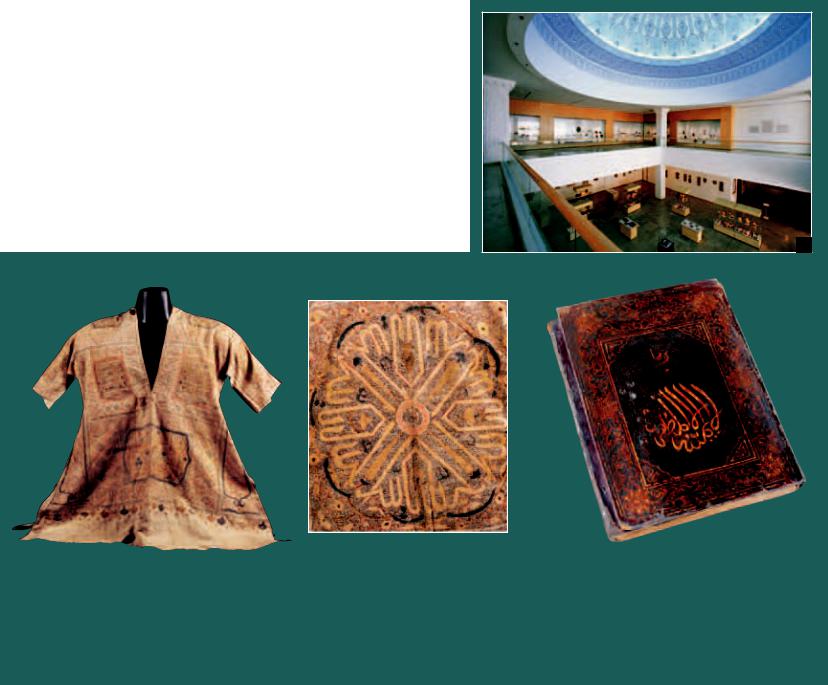
the attention it deserves (Flopp 1997: 161–178).
A collection management policy is a comprehensive statement based on museum culture that sets forth the goals of a museum and explains how these goals are pursued through collection activities. One of the main functions of the policy is to give guidance to the staff members in carrying out their responsibilities related to the museum collection (Fahy 1995: 13).
Managing the Islamic heritage based on Islamic culture and worldview is a new concept and a challenging task. A curator, conservator or restorer must keep in mind the importance of the rules set by the shari’ah of Islam, alongside the general knowledge on collection care based upon scientific analysis and museum standards.
The Islamic Arts Museum Malaysia (IAMM) located in Kuala Lumpur is a young museum with a commitment to becoming the custodian, preserver, conservator and educator of Islamic art heritage for future generations (Fig. 12) (Islamic Arts Museum Malaysia 2002). As a specialized museum in Islamic arts, we feel that it is our duty to take steps, however small and modest, to give this museum its ‘Islamic identity’, and to align our moves and acts in the course of collection care as much as possible in accordance with Islamic teachings.
To ensure respect for religious prescriptions and religious expectations in the curatorial department of the museum, we developed an internal manual describing the policy and procedures of the curatorial department to present to the museum management and then the staff. A small part of the manual is a procedure for the handling of manuscripts of the Qur’an in accordance with Islamic values. As mentioned earlier, all Islamic schools concur that it is prohibited to touch the Qur’an without prescribed purity, but they differ regarding the permissibility of someone in a state of minor impurity of blood and
12
figurE 10a talismanic tunic. turkey. 16th century CE. shoulder to shoulder: 90 cm; collar to hem: 74 cm. Collection of theislamic arts museum malaysia,
figurE 10b detail of fig. 10a showing the Quranic verses.
figurE 11 Qur’an. China. 17th century CE. 27x 19.5cm. Collection of theislamic arts museum malaysia. figurE 12 islamic arts museum malaysia: the Ceramic gallery overlooking the Qur’an andmanuscript gallery.
9 • Collection management of Islamic heritage in accordance with the worldview and Shari’ah of Islam |
99 |
|
|
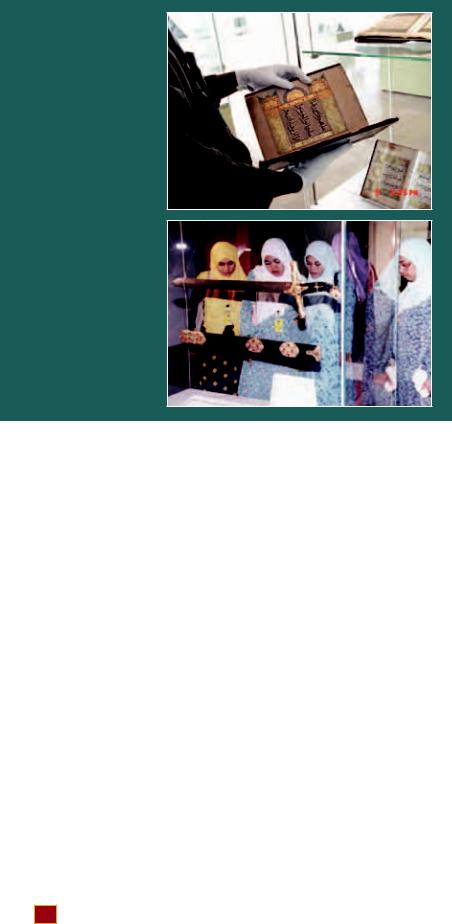
figurE 13 handling the Qur’an.
figurE 14 at the exhibition of ‘fakhr al-suyuf- the glorious swords’, august 2002. islamic arts museum malaysia.
excrement writing a Qur’an, touching it through an intervening medium, and wearing it as an amulet (Bakhtiar 1996). According to the Ja’afari School, it is forbidden to touch the Arabic script of the Qur’an without an intervening medium, irrespective of whether the script is in the Qur’an itself or somewhere else. It is also forbidden to touch the glorious name, Allah, for a person even in a state of only minor impurity (ibid).
Thissmallsectionquotedbelowmaybeconsidered as a tiny step and modest move towards the preservation and the maintenance of sacred boundaries related to the museum collection management. The following statements are under section 6.3 entitled ‘Handling procedures for Qur’ans’.
•The Qur’an is a holy book of the Islamic religion, and therefore should be treated with the same respect accorded to holy books and objects of other religions.
•Given the cross-cultural nature of the people employed with the museum, all staff (Muslims and non-Muslims) should be mindful of the special handling considerations associated with the Qur’ans contained within the IAMM collection.
•Muslims are reminded they should wash their hands according to the prayer wudhu rituals prior to handling the Qur’an.
•Non-Muslims should always wear gloves when handling Qur’ans (Fig. 13).
•The Qur’an should never touch the floor. If a Qur’an is accidentally, or inadvertently, placed on the floor, no-one should cross, or step over the Qur’an.
•The Qur’an should always be carried, placed or stored in a position that is higher than waist level.
•Be mindful that the curatorial affairs staff will be
subject to scrutiny from people both within the museum, and from people outside the museum. Therefore, strict observance of this procedure must be followed when handling Qur’ans in the galleries, or when assessing Qur’ans for donation, loan or purchase in front of potential depositors.
Here a note must also be added about the impure or unclean substances that must not come in contact with the sacred scripture. As mentioned earlier, pig and dog are two animals considered impure (najis) by the Islamic faith. This impurity, according to many schools, applies to the saliva, blood and other secretions of parts of the body of the said animals. This means that, if a certain kind of adhesive is developed from such material, it will be banned from use in the restoration and the conservation of the holy texts.
For a curator and a conservator of Islamic art, the knowledge of the nature of the material used in the process of conservation and restoration is therefore of utmost importance.
The hair and fur of the said animals when moist or wet can also transfer impurities through touch. Brushes made of pig hair are widely used nowadays. They are used in painting as well as in the restoration and conservation of artefacts. One must ensure that such brushes are not used in retouching a holy text, and other restoration works. As general advice, brushes made of such materials should be substituted with other materials in conservation laboratories and workshops that deal with Islamic artefacts.
In this regard, in the curatorial department of the museum we developed an internal procedure concerning tools such as brushes to be used on Islamic art objects. The small sections quoted below may also be considered as a tiny step and modest move towards the preservation and the maintenance of sacred boundaries. Part of section 1.23 under labelling or marking system reads:
•Brushes made of pig bristle and dog hair shall not be used as tools for labelling or marking Islamic art objects.
Also the following statement in section 4.3 under minimum conservation standard is worth mentioning:
100 ConservATIon of LIvInG reLIGIous HerITAGe

•Tools such as brushes made of pig bristle and
dog hair shall not be used for fillings, retouches and other conservation and restoration works of Islamic art objects. Also adhesives and solutions used in the conservation and the restoration of Islamic art objects should be free of ritually impure substances extracted from pigs and dogs. The exposition of objects, and visitor reactions
to displayed artefacts of a sacred nature, is another issue that can be noted here. The Islamic Arts Museum Malaysia has organized with the collaboration of different Eastern and Western countries several national and international exhibitions, which contained significant historical works of Islamic art. Among such exhibitions are: The Light of Qur’an (1999), Dress for the Body, Body for the Dress (2000), The Sacred Art of Marriage – Persian Marriage Certificate of the Qajar Dynasty (2000), Six Centuries of the Islamic Art of China (2001), Islamic Art of India (2002), Beyond Boundaries – Tents of the Islamic World (2002) and Between Eden and Earth: Garden of Islamic world (2003).
On 1 August 2002, the management of the Islamic Arts Museum Malaysia decided to present a special display to the Malaysian public entitled ‘Fakhr Al-Suyuf – The Glorious Swords’ from the museum collection. This exhibition featured fourteen replicas of the swords of the Prophet, the Khulafa Rashedin and his companions, revered for their contribution to the Islamic faith. The highlight of the exhibition was a replica of the famed Zulfakar, the sword of Prophet Muhammad that was handed to the fourth Righteous Caliph, Saidina Ali ibn Talib, after his death (Fig. 14).
According to our monthly comparative study on the museum temporary exhibitions from 1999 to 2002, surprisingly the number of visitors has increased tremendously. Of course the media exposure contributed to this popularity. However, the important aspect that we believe interested the public – men, women, children and the elderly – was the content of the exhibit and the way these swords were connected to their glorious heritage. The idea that these items were carried by the most holy people, those who were the pioneers of the religion, suggested a halo of sacredness around them – something that people could relate to. This is an aspect usually hidden from the eye of ‘technical’ people, curators and scholars alike – for them, the historical authenticity of the work has primacy.
The point that we would like to make here is that the managers of religious heritage have to extend their vision beyond the mere historical and technical aspects of the artefacts to the realm of the spirit of the religion itself. They must gain an understanding
of the thinking of the faithful people who produced their work.
Conclusion
What we have presented in this paper is nothing new. We have only tried to present a traditional view of the preservation of a tradition – something that the peoples of Islamic faith were doing in a very natural manner as a minor religious duty. The preservation and the maintenance of any heritage will best be achieved if the public are involved. The valuable religious heritage, which we have in our hands today, has survived only through the actions of those responsible communities that have guarded them until now.
In this paper, we have touched only the surface of a vast and deep ocean. But water – even a drop of it – may introduce in its humble way the nature of a great ocean. Speaking of the worldview and shari’ah of Islam in such a short paper as this one, setting guidelines for the maintenance of sacred boundaries, and preparing management plans, are definitely beyond the scope of this brief introduction. But then the longest journeys begin with a single step.
Bibliography
Bakhtiar, L. (1996), Encyclopedia of Islamic law: a compendium of the views of the major schools (Chicago, IL: ABC International Group).
Burckhardt, T. (1976), Art of Islam: language and meaning
(London: World of Islam Festival Pub. Co.).
Drijvers, Hans J. W. (1987), ‘Ablution’ in Eliade, Vol. 1, 9-13.
Eliade, M. (editor in chief) (1987), The Encyclopedia of Religion, 16 vols. (New York: Macmillan Publishing Company).
Encyclopedia of Islam, New edition, 11 vols. (Leiden: Brill, 1960).
Fahy, A. (ed.) (1995), Collections Management (London: Routledge).
Flopp, M.A. (1997), Managing Museums and Galleries, (London: Routledge).
Gleave, R. and Kermeli, E. (eds.) (1997), Islamic law, theory and practice (London: I. B. Tauris).
Islamic Arts Museum Malaysia, Vol 1 (2002) (Kuala Lumpur: IAMM Publications).
Malaro, M. (1995), ‘Collection Management Policies’, in Fahy 1995, 13.
Nasr, H.S., (1985), Ideals and Realities of Islam (London: Allen & Unwin).
Nasr, H.S., (1987), Islamic art and spirituality (London: Routledge & Kegan Paul).
Preston, James P. (1987), ‘Purification’ in Eliade, Vol. 12, 91-99. Valliere, P. (1987), ‘Tradition’ in Eliade, Vol 15: 1-15.
8 • Collection management of Islamic heritage in accordance with the worldview and Shari’ah of Islam |
101 |
|
|

10
[The collections of the Israel Museum in Jerusalemcontain a vast number] of objects with
deep links to the three main monotheistic religions, Christianity, Islam and Judaism. The largest is the Judaica collection. sacred objects demand special consideration when being collected, displayed, stored or undergoing conservation treatments. It is the duty and responsibility of the conservator to be aware of the sensitivities surrounding a religious object that is brought in for conservation.
A successful conservation treatment can be a failure from a religious point of view.for example, the use of pigskin to carry out the repair, however perfect, of a binding made for an Islamic Koran or a Jewish prayer manuscript would be disastrous in this sense. Conservation practice and ethics cannot depend purely on technique. They must reveal and explore the meaning beyond the physical state of an object. This paper is concerned with some questions in the field of paper and parchment conservation in relation to Jewish sacred objects. The considerations involved have to do with the materials we select
and the treatments we choose. Jewish Law codified in the ‘Halacha’ has very strict laws regarding the preservation, maintenance, storage and disposal of the Holy Bible and other sacred objects. These limitations place a burden on the conservation process and on providing answers to issues of conservation, and leave many questions yet unanswered.
[ miChaEl maggEn]
The conservation of sacred materials in the Israel Museum
mportant sacred religious objects belonging to |
curtain), the Torah scroll cover (which covers the |
the three main monotheistic religions, Christi- |
scroll); |
anity, Islam and Judaism, are part of the Israel |
• Ceremonial objects: candle holders (for Sather |
Museum collections. These items have always |
day or Hanukah), holy wine cup, and incense |
ibeen subject to research, which adds meaning to |
holders; |
our cultural and religious heritage as expressed by |
• Personal holy objects: Tfilim4, Mezuzah5 and |
the Museum’s exhibitions. The Judaica collection in |
Talit6. |
the Israel Museum includes the following objects of |
There are also two complete synagogue interiors |
sacred materials (the items are ordered by degree of |
(one in Italian and the other in Indian Jewish style) |
religious importance): |
within the Judaica permanent display area. There |
•Holy texts, prayers books and manuscripts: are more objects or documents that can be catego-
Torah scrolls, Sidur1, the Book of Esther, Passover Hagadah2, the Old Testament (Pentateuch);
•Holy Banners: Mizrach3, the Ten Commandments;
rized as less sacred items, such as Jewish matrimonial contracts. However, they have important ethnographic and artistic values. When sacred material becomes part of the museum collections, there
•Holy objects associated with the Torah scroll: are some additional considerations regarding their
the Torah scroll closet and Parochet (the closet |
maintenance, conservation and display. The religious |
102 ConservATIon of LIvInG reLIGIous HerITAGe
point of view and sensitivities regarding sacred objects must be respected and understood.
Such considerations can result sometimes in professional conflicts, as the following example illustrates. An enquiry addressed to me by a conservator of manuscripts in a leading museum stated:
We have recently acquired a very large Torah scroll from a private collector in Washington DC…The scroll has no roller bars, nor any protective housing, and it is in somewhat poor condition with many seams coming apart at the top and bottom, localized water damage and associated cockling, and numerous parchment repairs that look like they were applied with some kind of animal glue... finally, are there religious implications for people like ourselves doing this [conservation] work, as opposed to someone trained to write and make Torah scrolls? What should we consider from the exhibition standpoint, if anything?
This paper describes some of the important ethical and professional questions related to conservation practice and display of Jewish sacred materials raised by enquiries of this sort.
The Jewish law (Halacha) and sacred materials
The Halacha is the codex of Jewish law, consisting of rules and regulations on religious observance as well as the rules regarding daily Jewish life. The Halacha is considered to be a continuation of the Law of Moses and has been developed through rabbinical interpretation and supplements over the centuries. Halacha is the legal continuation of the Talmud, which is the accumulated oral traditions of theological thought inside the Jewish community through the centuries, and now transferred to written form. The origins for the Halacha go back more than two thousand years to Moses on Mount Sinai.
Jewish Law codified in the Halacha has very strict laws regarding the preservation, maintenance, storage and disposal of the Holy Bible and other prayer books, documents and objects. For example, the Holy Bible or the Torah scroll is regarded as the most sacred and important object in Jewish religion (other religious manuscripts or prayer books are of a secondary importance). Also important are phylacteries (in Hebrew teffilin) and the Mezuza which are personal ceremonial objects. The Bible is compared to a king or kingdom and, in this respect, whenever a new scroll is finished and brought into a synagogue, Orthodox Jews celebrate the event as
if a new king was born. The Bible can be used only for one purpose, which is reading and learning God’s wisdom; any other use is prohibited. Displaying the Torah scroll in a museum can, from a religious point of view, be permitted only if Jews are present among the visitors. The scroll must be open to allow the visitors to read from it.
There are also some restrictions and limitations from a religious point of view regarding the display and conservation of other sacred objects. A person who is not Jewish cannot carry out any conservation on Torah scrolls; men or women can practice conservation as long as they are Jewish. Of the two categories of conservation materials, organic and synthetic, there are no restrictions for synthetic materials but, for organic materials, the Jewish law would exclude any use of organic material which is not ‘kosher’. Organic material such as gelatine glues, which are products of certain types of non-kosher fish, are unacceptable (pers. comm. Rabbi Haim Dinovitch, 2003).
Jewish Manuscripts and Documents
Jewish marriage contracts, called in Hebrew Ketubbah (plural Ketubbot), have become very popular and sought-after art objects among collectors and art institutions. These documents are vital sources for ethnographic research. Thus Dr Moses Gaster, author of the first book about Ketubbah, ended his ground-breaking research on an emotional note: ‘[the Ketubbah] is without a doubt the most fascinating and romantic chapter in the history of Jewish civilization’ (Gaster 1974).
In this context, the early sixteenth–seventeenth century Italian Ketubbot are rare and highly regarded. Many of these documents were written on parchment and decorated with watercolours. The Ketubbah, being a legitimate contract between a husband and wife, ensures the bride rights, property, and prosperity, and was always given to the bride by the bridegroom. The document used to be folded a few times for practical reasons and kept with all the other important family records.
Today, many Ketubbot, for similar practical reasons, are unfolded and flattened to meet storage and exhibition needs, leaving only a small trace of the original folds (Fig. 1). From the conservation point of view, such small changes are at the edge of acceptable practice. The example from the Israel Museum collection illustrated in Fig. 2 is a beautiful nineteenth century Ketubbah from Rome, written on parchment and painted with watercolours, tempera pen and ink. The gate motif in this Ketubbah is richly decorated and illuminated with colours. It is very sad to see
10 • The conservation of sacred materials in the Israel Museum |
103 |
|
|
